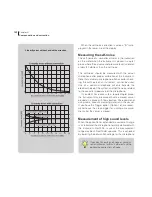
105
Norsonic Nor140
Instruction Manual
noise method if option 10, internal noise generator, is
additionally installed. An external noise signal can also
be used. The integrated impulse response method
is often called Schroeder method after Dr. Manfred
Schroeder who disclosed the theoretical relations be-
tween this and the interrupted noise method. The re-
verberation time is extracted from the decay by the use
of a least mean square fit algorithm.
A third way of reverberation time measurements
is also available. This measurement option enables
a swept sine excitation signal. Sophisticated signal
analyses of the measured response gives robust and
accurate results.
The decay curve measured with the interrupted
noise method is the result of a stochastic process,
and averaging several decay curves or reverberation
times measured at one microphone/loudspeaker posi-
tion is mandatory in order to obtain a representative
value. The integrated impulse response of a room is a
deterministic function and not prone to statistical de-
viations, so no averaging is necessary. However, for
many applications you still need spatial averaging, as
described in the measurement standards
Calculating the reverberation time
Measurement with noise excitation
Measuring the reverberation time by using interrupted
noise is often referred to as the classical method. The
noise source is switched on for a time sufficient to ob-
tain a steady level. The source is thereafter switched
off, and the decay of the sound in the room is ob-
served. Without loss of generality, the time for switch-
ing the noise off may be set to t = 0.
A plot of the sound pressure level versus time will
in general contain information on the obtained station-
ary sound pressure level in the room L
0
as well as the
reverberation time. A typical level versus time diagram
is shown on the adjacent figure. The background level
is indicated as L
N
Information about the decay will be given for t > 0.
The decay may be further processed to obtain the re-
verberation time.
The classical methods for the measurement of air-
borne sound in rooms, defined in ISO 3382-series of
International Standard specify a stochastic signal for
the excitation. Although the room in most cases may
be described as a deterministic system, statistical
spread from the random excitation will lead to a certain
stochastic variation in the result, which may be charac-
terised by a standard deviation.
Reverberation decay
Therefore, averaging of more measurements is nor-
mally needed to obtain results close to the stochas-
tically expected values. Such averaging may for the
classical method be combined with the spatial averag-
ing needed to obtain a mean value for the room.
Summary of Contents for nor140
Page 4: ......
Page 16: ......
Page 17: ...nor140 SOUND ANALYSER ...
Page 18: ......
Page 212: ...194 ...
Page 218: ......
















































